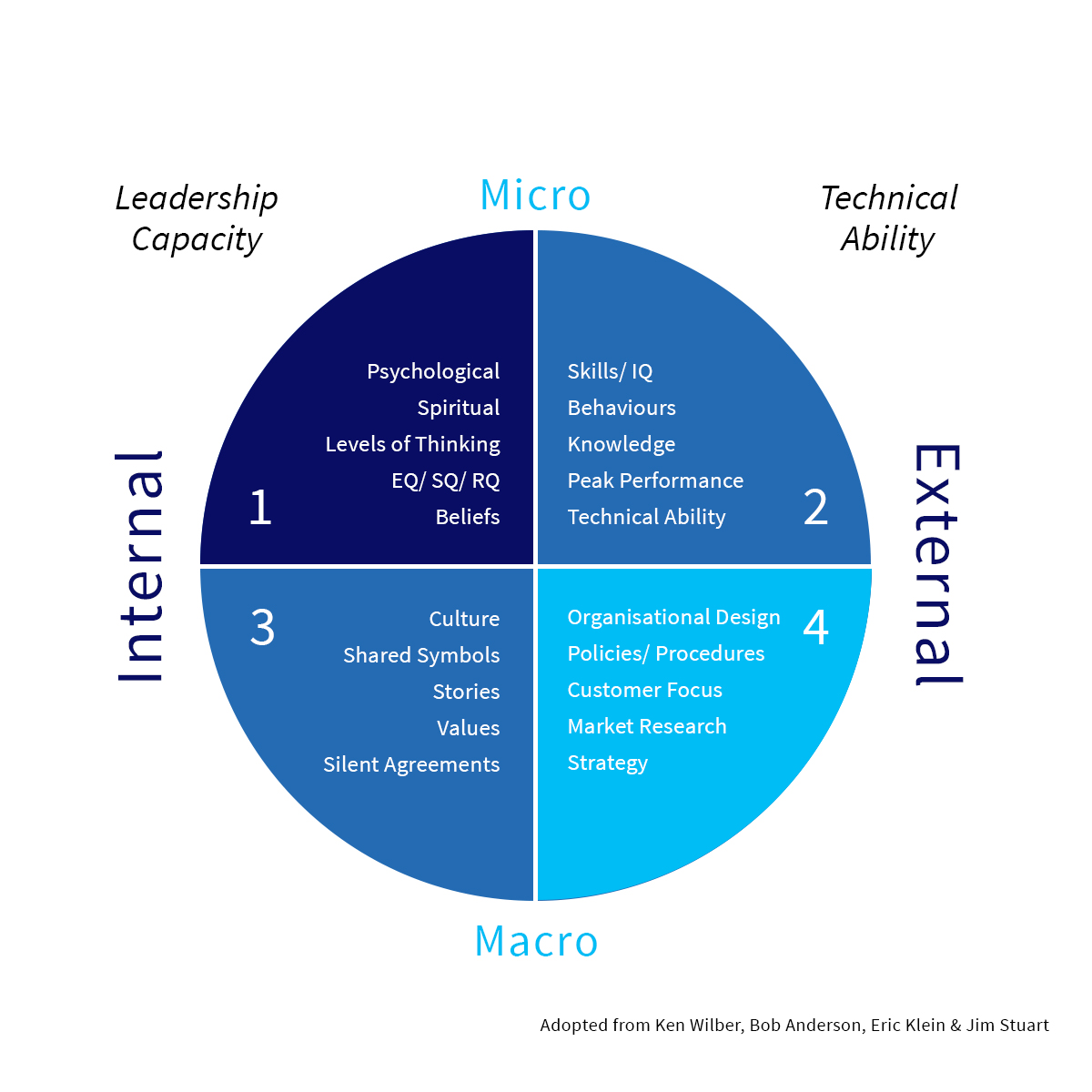
Achieving Whole System Change
For a system to change it needs to change from within and it must involve all aspect of the system as an integral whole. Organizations are designed to create order and maintain it. If you want it to change you have to attend to what is required for it to change. Partial change will lead to reversals that simply serve to reinforce the idea that people and organizations do not change. People only change if it makes sense and the system and the collective work together to create the new order. It takes great courage and the willingness to embrace the inherent risks of disrupting things. Developing flexibility in systems is the new leadership challenge.
Organizations are living systems. They evolve over time in response to the forces at play that influence their development. Those forces may be internal or external. Sometimes it is a special capability someone brings, a change in the market, a demand from a significant client, a complication such as a resource no longer available, an expansion, a contraction or solving a certain problem. How people respond to events and circumstances shapes the organization and its ability to serve the market. The leadership of the organization determines this as they typically have the biggest influence on the organizational system.
What drives most organizational change efforts is the desire to achieve the vision for the organization and the realization that the current situation has limitations, some things are working against achieving that outcome and therefore need to change. The organization is a complex integrated system where all the elements are interconnected and as one change occurs so do others not necessarily in a predictable way. In designing change efforts we need to bring the whole system into view, both the tangible and intangible and understand the interconnectedness and interdependencies. Only when leaders can intentionally address all parts of the system effectively will change efforts deliver the desired results.
The Four Quadrants of Organisational Change

The vertical axis
addresses the
individual/micro
and the collective/
macro aspects
and the horizontal
axis addresses the
intangible/internal
and tangible/
external aspects
of the organisation.
Quadrant 1 (People)
Individual/Internal = what makes people tick, what we think and feel and how we make meaning of things. It includes our intentions, motivations, beliefs and attitudes and cognitive processes including our subconscious drivers. People will embrace change when it makes sense at this level. The subconscious can actively work against conscious decisions and good intentions. This is where personal inner development is important; when we have awareness we have the full potency of choice. This is the greatest source of deep lasting transformation.
Quadrant 2 (Performance)
Individual/External = what can be observed and managed, what we say and what we do. It includes our behaviour, performance, skills and results. There are many ways that people try to achieve peak performance. Much of behavioural science focuses on this, as do performance and rewards systems. It is the outside evidence of what is going on internally. When we say one thing and do another it points to something out of our awareness that is inconsistent, usually something internal hence the interconnectedness with Q1.
Quadrant 3 (Culture)
Collective/Internal = what is important to us collectively, what values, standards and influences have currency in our group. It includes our shared purpose as enacted, reinforced values, rituals, iconic stories, and silent agreements. It is not so much what we say but rather what we do when we are not paying attention. It is all the subtle things that communicate most influentially to shape the culture. The formal messages are not as powerful as the informal unless they both reinforce each other. A values statement won’t work unless the leaders are walking talking examples of the vision and values, even in the smallest things. This links back to Q2, what do leaders choices, decisions, actions, comments communicate moment by moment, what is the dominant pattern. To shape a culture requires awareness and mindfulness, and links back to Q1.
Quadrant 4 (Systems)
Collective/External = what structures do we have that create order in the system enabling us to get things done. It includes the social, technical & organisational systems; organisational design, technology workflow, policies and processes. The structure itself communicates cultural messages. The processes that get priority do too. A fundamental principle for effective systems is that they are designed well; structure is the dominant influence on performance.. A well-designed process enables and enhances performance. If a system is poorly designed it will create pressure on other parts of the system, which then require people to act to overcome the poor design. Different people will do that in different ways that can lead to conflicts in the culture, disruption of relationships, demands on skills and impacts on people’s motivation Q3, Q2 & Q1.
Challenges to Change
The greatest challenge with effecting change is to work on all 4 quadrants and ensure they support and reinforce each other rather than inadvertently work in conflict. It is common in organisations to work diligently on quadrant 2 & 4 and expect that to work. This makes sense as it plays into the technical skills that people develop to advance in organisational life. Being good at your work and getting results typically leads to advancement. Designing new approaches and directing people to new behaviours and approaches in theory will work until they butt up against internal limitations that they are unaware of. Try as they might it doesn’t translate into new behaviour, either as a function of their own sense of self, how others interact with them or perhaps cultural forces that unless brought out into the open to be examined and transformed reinforce the old behaviours.
A 2-quadrant approach is not enough to lead complex organisations in rapid changing environments that require flexibility, innovation and agility – the capabilities of adaptive leadership. These are leadership game changers and require development and advanced capability in the left hand quadrants Q1 & 3. Equally organisations that focus on the Q1 & 3 are limited in their effectiveness.
For organisations to change it requires that everyone in the system change including the leaders. Any system will be limited by the level of consciousness of its leaders and the way that consciousness is expressed in the culture. These are quadrants 1 & 3.
It is relatively easy to analyse situations objectively and identify what needs to change. The next critical step is to make it personal to see how you are part of the system and what your role is in the current situation, what do you need to change in order to enable the system to change. Then go to work on what you are responsible for. This is what typically is the limiting factor of successful change initiatives, seeing others limitations, directing others to change without changing yourself.
This can be the greatest hurdle is to acknowledge the limitations of familiar ways of getting things done. Moving into a new learning phase that requires discovering the indirect leadership capabilities of inspiring, creating, influencing and leading collaboratively and through others. Letting go of control and developing ways of building environments where people choose to step up and achieve out of a deep sense of personal purpose and vision aligned to the shared organisational purpose and vision and values arising from a personal commitment and sense of ownership. This is based on quadrant 1, the most potent lever for transformational change and transformational leadership.
By going through it yourself you understand the journey through the lived experience and then can lead in a way that supports others to make the same journey in their own way. This more sophisticated form of leadership requires a very different relationship with our sense of identity. We move from an expert achiever to a facilitator enabler and then collaborative co-creator.
Our sense of who we are and what makes us worthwhile will change over time if we are growing. However at any stage we can become over identified and steadfastly want to remain in our comfort zone. We might like feeling like an expert and all the sense of security that goes with that or like a particular achievement of ours and start to believe no-one can do that as well as I did. This identification may be unconscious but driving our attitudes, beliefs, mindset and motivations. It can make us blind. The psyche is very capable of denying or distorting something it doesn’t want to face. Change inherently challenges our status quo, our identity, what we are comfortable with. Unless we are willing to examine it and transform it we will revert to our familiar ways and then we are the obstacle to change. There is every reason to resist it. Quadrant 1 work is most uncomfortable and confronting until we learn how to do it then the more we do it the more competent we become at insightfully responding to the forces at play and become the flexible adaptive leaders we need to become to transform organisations. The truth is if we don’t learn to do it we are the limitation in the system.
To learn more set up a time to have a conversation with Sarah. To get in contact please email her EA, Leanne Imbro on ea@sarahcornally.com or call 02 9801 0659.
You may publish this article as long as the following notice appears attached to the article, and you advise Sarah Cornally – info@sarahcornally.com where it will be published.
Copyright © 2016 Cornally Enterprises. Permission has been granted to publish this article in full, sourced at www.sarahcornally.com








